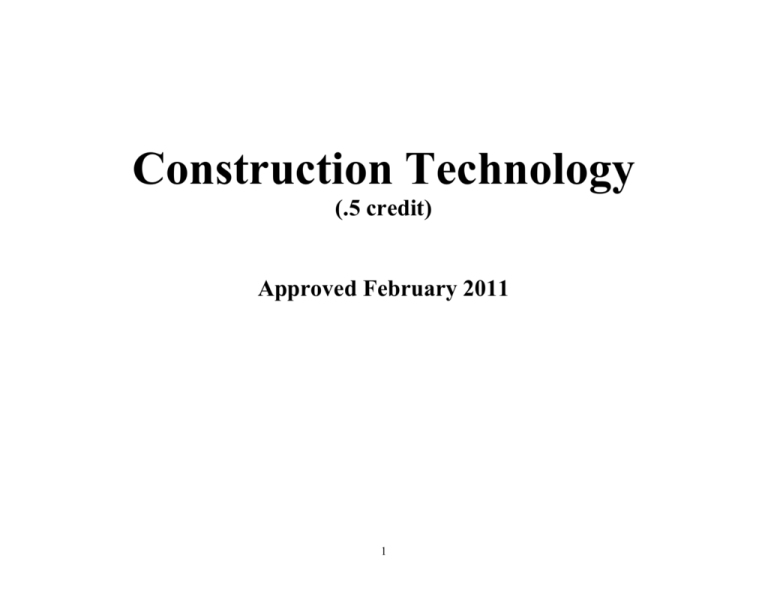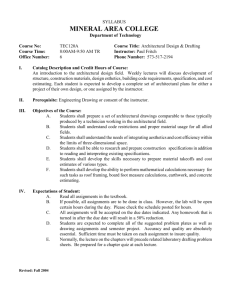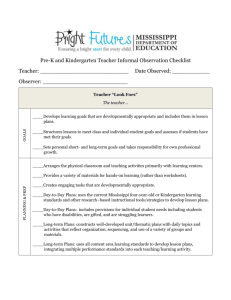Construction Technology
advertisement

Construction Technology (.5 credit) Approved February 2011 1 Fundamentals of Construction Technology and Safety Issues Essential Understandings: 1. The resources, processes, concepts, and tools of technology must be used safely and effectively. 2. The study of technology includes fundamental components that have evolved over time. 3. Quality workmanship and systematic problem solving are essential components of technology. 4. What we learn through the study of technology can be applied to other disciplines. Content Standards: 1. Understand the impact that technology has on the social, cultural, and environmental aspects of our lives. 2. Recognize technology as the result of a creative act, 3. Apply disciplined problem-solving strategies to enhance invention and innovation. 4. Develop interpersonal, team, and leadership skills. 5. Understand and demonstrate the process of turning raw materials into a finished product. 6. Understand the basic health and safety concerns when using tools. Essential Questions: What are the fundamental components in the study of construction technology – past, present, and future? How can the basic knowledge of construction be applied to other disciplines? What are the essential safety requirements in this field of work? What career opportunities are available in the field? Learning Goals: Students will.... Understand the technology concept of the “System Model.” Become familiar with the main types of construction and the design process involving the owner, architect, contractor, and building officials. Understand the applicable building codes and relevant laws that regulate construction practices. Recognize career opportunities in the area of construction technology. Demonstrate the safe use of all construction power tools, and processes using materials in the Technology Lab. Apply reading, writing, speaking, listening, inquiry, and research skills to the study of construction technology. 2 Suggested Strategies Suggested Assessments Suggested Resources Suggested Tech Integration Content Vocabulary Lifelong Learning / 21st Century Skills Practical “hands-on” instruction in the safe use of all applicable power tools in the Technology Shop. Demonstration of safe material handling. Individual and group activities. Teacher initiation discussions. Observed performance by the students and a practical written “safety test.” A research paper detailing a specific form of construction and the included applicable technology components. Safety test. The technology lab and power tools. Topic specific worksheets. “Smart” tools. Input, Process, Output, Feedback, residential construction, commercial construction, civil or heavy construction, superstructure, substructure, client, Architect, Engineer, GC (General Contractor), subcontractor, Building Officials, CPM (critical path method), change orders, bid packet, OSHA, ADA, Building Codes, occupancy rating. Collaborate and cooperate Communicate effectively Access and process information Quality work Productive habits of mind: self-regulated thinking 3 Measurements & Communication Essential Understandings: 1. The resources, processes, concepts, and tools of technology must be used safely and effectively. 2. Effective strategies help us adjust to new technologies and the changing interactions among science, technology, and society. 3. Quality workmanship and systematic problem solving are essential components of technology. 4. Technology significantly influences consumer and career choices. Content Standards: 1. Understand the impact that technology has on the social, cultural, and environmental aspects of our lives. 2. Recognize technology as the result of a creative act. 3. Be able to apply disciplined problem solving strategies to enhance invention and innovation. Essential Questions: What are the roles of the different forms of communications in construction technology? What drawing skills are needed for paper-based drafting? What drafting concepts are needed for effective communication? Why is the ability to measure accurately essential in the construction trades? Learning Goals: Students will.... Process, transmit, receive and organize information using electronic, physical, and graphic communications. Develop a familiarity with conventional board drafting equipment. Identify all of the terms associated with topographic map reading. Demonstrate the core drafting concepts of standardized lettering, accuracy, basic linear measurements, scale measurement (architectural and engineering), drawing standards, construction drawing standards, and the reading of construction drawings (blue print reading). Show understanding of basic topographic map reading as it applies to site selection and building orientation. Apply basic measurements techniques and surveying concepts to constructing a paper based drafted plot plan. Use a level-transit and demonstrate an understanding of surveying a site in the field. Understand the role electronic communications in transmitting/receiving both documents and audio information on the job site. 4 Suggested Strategies Suggested Assessments Suggested Resources Suggested Tech Integration Content Vocabulary Lifelong Learning / 21st Century Skills Individual practical “hands-on” instruction in drawing with conventional board drafting equipment. Progressions from simple to more advanced assignments. Exposure to the architectural, engineering and metric scales in construction. Basic construction drawing (blue print) reading and survey techniques. Individual practical “hands-on” instruction in the use of a level-transit and survey in the field. Teacher initiation discussions. Observed performance by the students. Assessment and feedback of the individual drafting assignments. Assessment and feedback of the level-transit and survey assignments. Drafting equipment. Examples of topographic maps. Examples of site plans from existing building. Level-transit survey equipment. Topic specific worksheets. Exposure to CAD systems/Programs (AutoCAD and Chief Architect) Scale (ruler), drafting triangle, protractor, compass, T-square, lettering, drafting line types and symbols, Architectural scale, Engineering scale, Metric scale, plans, sections, elevations, details, level-transit, plot plans, survey, graduated circle, quadrants, angular measurements (north, south, east, west, degree, minute, second), monument, contour lines, building lines. Access and process information Communicate effectively Access and process information Productive habits of mind: critical thinking 5 Construction of a Vacation House Model Essential Understandings: 1. The resources, processes, concepts, and tools of technology must be used safely and effectively. 2. Effective strategies help us adjust to new technologies and the changing interactions among science, technology, and society. 3. Quality workmanship and systematic problem solving are essential components of technology. 4. Technology significantly influences consumer and career choices. Content Standards: 1. Understand the impact that technology has on the social, cultural, and environmental aspects of our lives. 2. Recognize technology as the result of a creative act 3. Apply disciplined problem solving strategies to enhance invention and innovation. 4. Understand and demonstrate the process of turning raw materials into a finished product. 5. Understand the basic health and safety concerns when using tools. Essential Questions: How do we correctly read a set of architectural floor plans? What calculations are required to prepare a cost proposal and how is a cost proposal submitted to a client? What are the legal documents required by the building process? What are the building standards for wood frame construction? Learning Goals: Students will.... Identify all of the building components/terms associated with site work and wood frame construction. Explain all the important elements of a complete set of construction documents, including all architectural drawings and specifications. Understand the processes of creating a material cost analysis from a set of construction drawings. Be able to develop a cost proposal form for a client using a standardized contract cost proposal. Understand the consequences of a standard construction contract (standard form of agreement between owner and contractor). Create a schedule timeframe for the construction using the CPM (critical path method) format. Understand the requirements of the local building department building/zoning permit. Construct a small wood frame model hut from a set of realistic architectural documents. Demonstrate standardized framing construction techniques in the construction of the small wood frame model hut. Create “cutting lists” for every major building stage of the construction process. Prepare a cost balance spreadsheet of final project costs. Recognize career opportunities in this area of learning. 6 Suggested Strategies Suggested Assessments Suggested Resources Suggested Tech Integration Content Vocabulary Lifelong Learning / 21st Century Skills Teacher initiation discussions of building components/terms associated with wood frame construction. Individual cost analysis of a small wood structure. The component parts are deconstructed and a $ value is associated with each item. Complete a standardize contractor proposal sheet for submittal to a fictional client. Complete a standardized Owner-Contractor contract for submittal to a fictional client. Individual practical “hands-on” construction of a wood model. Appling the basic knowledge of wood frame construction to the building of a scale model hut. Create a cost balance spreadsheet using the individual construction material costs and the actual materials used for a final project cost. Use of topic specific worksheets. Observed performance by the students. Assessment of the cost proposal and final cost analysis. Assessment of a completed model. Vacation House Construction contract documents. Packet includes a complete set of construction drawings and AIA formatted specifications. E-Z Contractor Forms #EZ110, contract cost proposal sheet. AIA document A107-2007, Standardized Form of Agreement between Owner and Contractor for a project of limited scope. BOCA Building Codes. Town of Durham Building/Zoning Permit. Supplies for the construction of the models. Microsoft Excel. Topic specific worksheets and outlines. Microsoft Excel Architectural contract documents, specifications, contract, proposals, plans, foundation, excavation, footings, slab, sole plate, rafters, joists, studs, footing, sill, headers, bill of materials, overhead, specifications, proposal, CPM schedule(critical path method) cost take-off, BOCA codes, permit. Communicate effectively Access and process information Quality work Productive habits of Mind: self-regulated thinking 7 House Wiring and Plumbing Activity Essential Understandings: 1. The resources, processes, concepts, and tools of technology must be used safely and effectively. 2. Effective strategies help us adjust to new technologies and the changing interactions among science, technology, and society. 3. Quality workmanship and systematic problem solving are essential components of technology. Content Standards: 1. Understand the impact that technology has on the social, cultural, and environmental aspects of our lives. 2. Understand and demonstrate the process of turning raw materials into a finished product. 3. Understand the basic health and safety concerns when using tools. Essential Questions: What are the basic components of the wiring and plumbing in wood frame house construction? What are the construction standards and practices required for safe wiring and plumbing? How does quality workmanship affect the final product? Learning Goals: Students will.... Identify all of the building components/terms associated with electrical wiring and water and waste plumbing. Understand the applicable building codes and relevant laws that regulate construction practices. Safely use the appropriate tools and machines to produce a quality finished product. Recognize career opportunities in this area of learning. 8 Suggested Strategies Suggested Assessments Suggested Resources Suggested Tech Integration Content Vocabulary Lifelong Learning / 21st Century Skills Practical “hands-on” instruction in the safe use of all tools associated with wiring and plumbing. Individual practical “hands-on” construction of a simple electrical house circuit and welding of materials (copper and PVC plastic) in plumbing fabrication. Teacher initiation discussions. Observed performance by the students. Topic specific worksheets. Supplies for the construction of wiring and plumbing systems. Topic specific worksheets. “Smart” tools NEC Code (National Electric Code), UL (Underwriters Laboratory), electrical box, pryout, AWG (American Wire Gauge), NMSC (nonmetallic sheathed cable), Romex, AC (armored cable), BX, GFCI (ground fault circuit interrupter) polarized plug, rough-in, DWV (drain, waste, vent), type “M” copper piping, type “L” copper piping, type “K” copper piping, torch, flux, solder, fittings, primer, sweat welding. Collaborate and cooperate Communicate effectively Access and process information Quality work Productive habits of Mind: critical and self-regulated thinking 9







